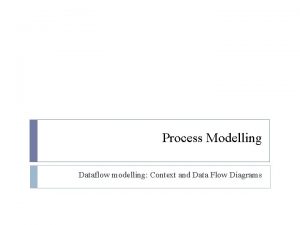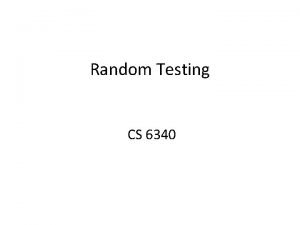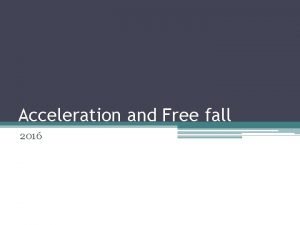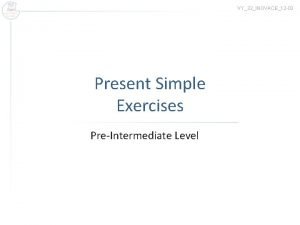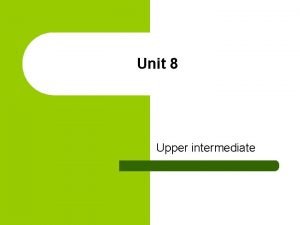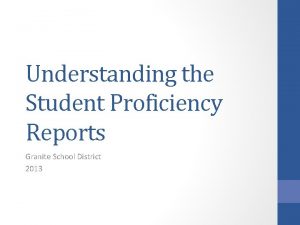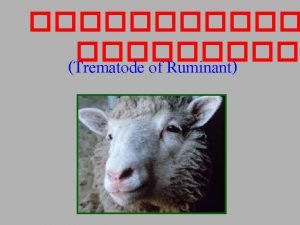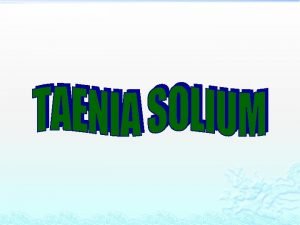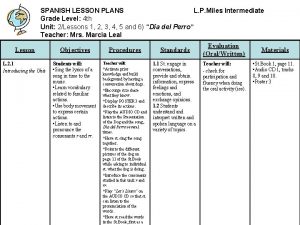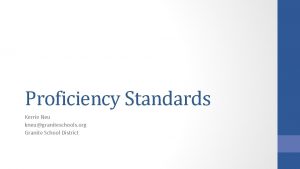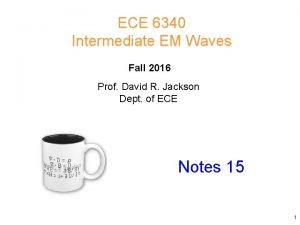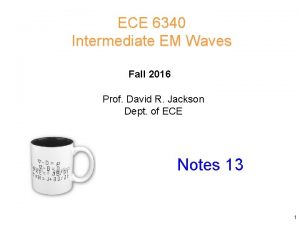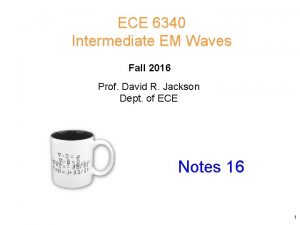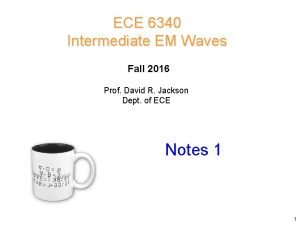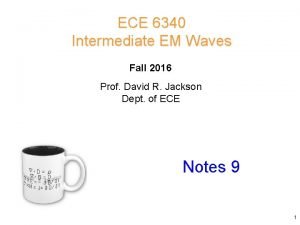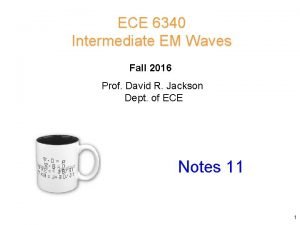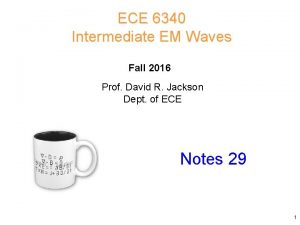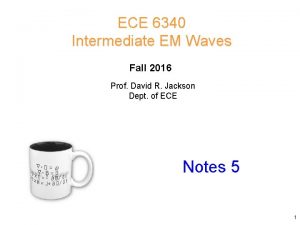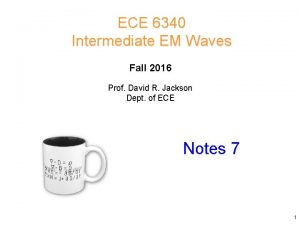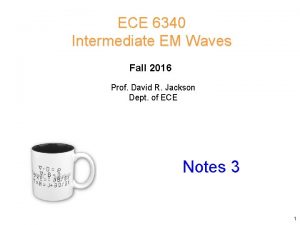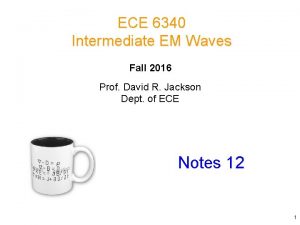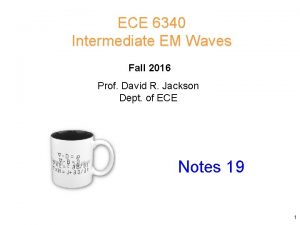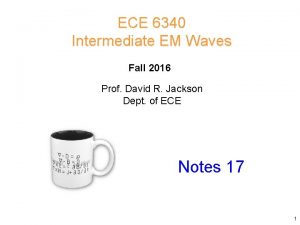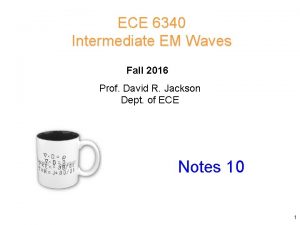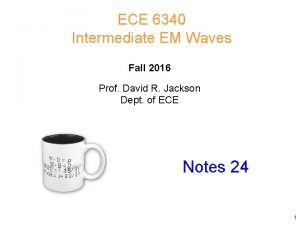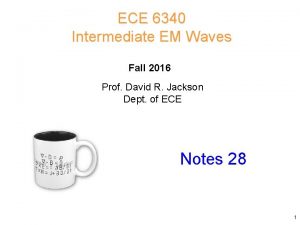ECE 6340 Intermediate EM Waves Fall 2016 Prof














![Filament “Testing” Current C a sources 1 [A] b source We sample a voltage Filament “Testing” Current C a sources 1 [A] b source We sample a voltage](https://slidetodoc.com/presentation_image_h2/c46e2c171da3c519fbf754411224a201/image-15.jpg)






![Example (cont. ) The field Ea is the field produced by the 1[A] feed Example (cont. ) The field Ea is the field produced by the 1[A] feed](https://slidetodoc.com/presentation_image_h2/c46e2c171da3c519fbf754411224a201/image-22.jpg)











- Slides: 33

ECE 6340 Intermediate EM Waves Fall 2016 Prof. David R. Jackson Dept. of ECE Notes 27 1

Reciprocity Theorem Consider two sets of sources, radiating in the same environment. Body Note: The same “body” (dielectric or PEC) exists in both cases. 2

Reciprocity Theorem (cont. ) Also, Subtract: 3

Reciprocity Theorem (cont. ) Vector identity: Hence, From duality (or repeating derivation using Faraday’s Law for “a” and Ampere’s Law for “b”) we have: 4

Reciprocity Theorem (cont. ) Multiply first equation by -1 and then add: 5

Reciprocity Theorem (cont. ) Reversing the order of the cross products in the first term on the LHS, Next, integrate both sides over an arbitrary volume V and then apply the divergence theorem: V S 6

Reciprocity Theorem (cont. ) Now let S S In the far-field, Hence 7

Reciprocity Theorem (cont. ) Now use a vector identity: So, cancels 8

Reciprocity Theorem (cont. ) Hence Therefore, 9

Reciprocity Theorem (cont. ) Final form of reciprocity theorem: LHS: Fields of “a” dotted with the sources of “b” RHS: Fields of “b” dotted with the sources of “a” 10

Reciprocity Theorem (cont. ) Define “reactions”: Then 11

Extension: Anisotropic Case If ij = ji and ij = ji (symmetric matrices) then reciprocity holds. These are called “reciprocal” materials. 12

“Testing” Current Some Basic Observations Ø To make the reciprocity theorem useful to us, we usually choose the “b” current to be a “testing” current or “measuring” current. Ø The “b” current thus allows us to sample a quantity of interest. Ø This allows us to determine some property about the quantity of interest, or in some cases, to calculate it (or at least calculate it in a simpler way). 13

Dipole “Testing” Current b source a sources We sample a field component at a point. 14
![Filament Testing Current C a sources 1 A b source We sample a voltage Filament “Testing” Current C a sources 1 [A] b source We sample a voltage](https://slidetodoc.com/presentation_image_h2/c46e2c171da3c519fbf754411224a201/image-15.jpg)
Filament “Testing” Current C a sources 1 [A] b source We sample a voltage drop between two points. 15

Magnetic Frill “Testing” Current b source C a sources I A wire is present as part of the "environment. " Note: There is no displacement current through the loop if it hugs the PEC wire. We sample a current on a wire. 16

Example Two infinitesimal unit-amplitude electric dipoles 17

Example Two infinitesimal unit-amplitude electric dipoles 18

Example The far-field transmit and receive patterns of any antenna are the same. Transmit r 1 [A] Measure Ep (with r fixed) 19

Example (cont. ) Receive VPW + A unit-strength plane wave is incident. 20

Example (cont. ) Next, define two sources: C We apply reciprocity between these two sources, keeping the antenna present. The antenna (and feed wires) is the “body. ” 21
![Example cont The field Ea is the field produced by the 1A feed Example (cont. ) The field Ea is the field produced by the 1[A] feed](https://slidetodoc.com/presentation_image_h2/c46e2c171da3c519fbf754411224a201/image-22.jpg)
Example (cont. ) The field Ea is the field produced by the 1[A] feed current exciting the antenna. C 1 [A] The antenna is the “body. ” Note: The black color is used to show where dipole “b” is, even though it is not radiating here. 22

Example (cont. ) Hence, we have 23

Example (cont. ) The field Eb is the field produced by dipole “b” in the far field. - Dipole “b” + The voltage Vb is the open-circuit voltage due to a unit-amplitude dipole in the far field. Note: The black color is used to show where filament “a” is, even though it is not radiating here. 24

Example (cont. ) As r , the incident field from dipole “b” becomes a plane-wave field. z' Local coordinates (for dipole “b”) ' r We need to determine the incident field E from the dipole: Let so 25

Example (cont. ) Define z' Local coordinates (for dipole “b”) ' r 26

Example (cont. ) Hence More generally, The incident field from the “testing” dipole thus acts as a plane wave polarized in the direction, with amplitude E 0 at the origin. Hence 27

Example (cont. ) Summarizing, we have: From reciprocity: so 28

Example (cont. ) Hence, in summary we have: The shape of the far-field transmit and receive patterns are the same. 29

Example Reciprocity in circuit theory I 12 I 21 Point 2 + - V 1 Point 1 V 2 I 21 = current at location 2 produced by V 1 I 12 = current at location 1 produced by V 2 Note: If V 1 = V 2, then the result becomes I 12 = I 21. 30

Example (cont. ) Magnetic frill modeling of voltage source z V + Ms K - K is the amplitude of the magnetic frill current that flows in the positive direction. 31

Example (cont. ) I 12 K 1 = -V 1 a b C 1 C 2 I 21 K 2 = -V 2 The sources (a and b) are the magnetic frills; the “environment” is the circuit. From reciprocity: 32

Example (cont. ) Hence or 33
 Dfd 6340
Dfd 6340 Cs 6340
Cs 6340 Transverse waves move perpendicular
Transverse waves move perpendicular Sound waves are mechanical waves true or false
Sound waves are mechanical waves true or false Mechanical wave examples
Mechanical wave examples How are rainbows made
How are rainbows made Characteristics of a longitudinal wave
Characteristics of a longitudinal wave Sound waves longitudinal waves
Sound waves longitudinal waves What is a semiconductor used for
What is a semiconductor used for Mechanical waves and electromagnetic waves similarities
Mechanical waves and electromagnetic waves similarities Mechanical waves vs electromagnetic waves
Mechanical waves vs electromagnetic waves Mechanical waves and electromagnetic waves similarities
Mechanical waves and electromagnetic waves similarities Seismic waves
Seismic waves Seismic waves are mechanical waves
Seismic waves are mechanical waves Compare and contrast p waves and s waves using venn diagram
Compare and contrast p waves and s waves using venn diagram Mechanical waves vs electromagnetic waves venn diagram
Mechanical waves vs electromagnetic waves venn diagram Difference between constructive and destructive waves
Difference between constructive and destructive waves Free fall 2016
Free fall 2016 Words their way intermediate spelling inventory
Words their way intermediate spelling inventory Jeremiah podczaszy
Jeremiah podczaszy Stehlik intermediate school
Stehlik intermediate school Have got has got exercises
Have got has got exercises Intermediate unit 8
Intermediate unit 8 Mood food english file key
Mood food english file key Novice intermediate advanced
Novice intermediate advanced Eurytrema pancreaticum life cycle
Eurytrema pancreaticum life cycle Toxoplasma intermediate host
Toxoplasma intermediate host Della icenhower
Della icenhower Gravid proglottid of taenia solium diagram
Gravid proglottid of taenia solium diagram Speech emergence stage activities
Speech emergence stage activities Lp miles elementary
Lp miles elementary Salina intermediate school
Salina intermediate school Novice intermediate advanced
Novice intermediate advanced Book value per ordinary share
Book value per ordinary share
